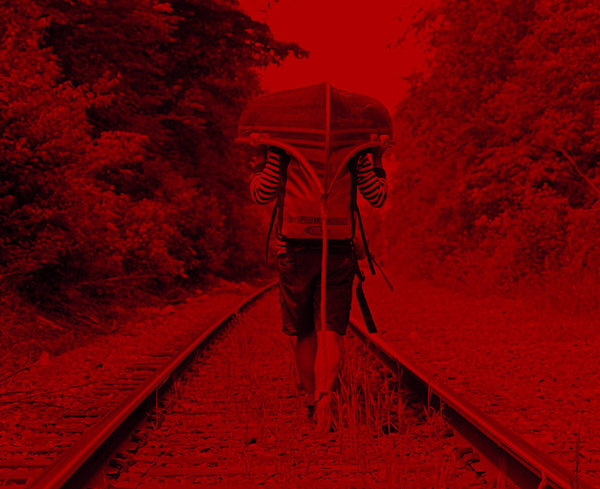Simon Starling
dal 29/10/2009 al 18/12/2009
Segnalato da
29/10/2009
Simon Starling
Casey Kaplan Gallery, New York
Red White Blue. His practice unfolds as a rich, web-like narrative through means of intensive research, process, performance, and production. The exhibition consists of a large-scale mobile entitled, "Project for a Temporary Sculpture (Hiroshima)". This installation continues the artist's research into the history of art institutions, and creates key links to the politics associated with atomic energy in the 1940's and 1950's.

Casey Kaplan is pleased to present Simon Starling’s fourth solo exhibition at the gallery. Starling’s practice unfolds as a
rich, web-like narrative through means of intensive research, process, performance, and production. Best described as a
"physical manifestation of a thought process," Starling’s work continues to illuminate significant connections between
economic, political, social, and artistic practices.
Initially prompted by an invitation to mount a solo exhibition at the Hiroshima City Museum of Contemporary Art for 2010,
Starling's show in New York consists of a large-scale mobile entitled, "Project for a Temporary Sculpture (Hiroshima)"
hanging from the gallery's ceiling in our middle gallery. This installation continues the artist’s research into the history of
art institutions, and more specifically the work of British sculptor Henry Moore. Previously Starling has made connections
between Moore and the Cold War through Moore's relationship with Sir Anthony Blunt (1907-1983, a double agent
working simultaneously for the NKVD in the Soviet Union and MI5 of the British government, Professor of History of Art at
the University of London, Director of the Courtauld Institute of Art, London, Surveyor of the Queen's Pictures, and an art
critic).
Starling's new work focuses on specific Henry Moore sculptures in the collection of the Hiroshima City Museum and the
Hirshhorn Museum and Sculpture Garden in Washington, D.C. that create key links to the politics associated with atomic
energy in the 1940's and 1950's. Moore was a public sponsor of the Campaign for Nuclear Disarmament (CND) yet he
received and accepted a commission to create the artwork "Nuclear Energy", 1964-66 which commemorates Enrico
Fermi’s first self-sustaining nuclear chain reaction in Chicago in 1942. Prior to the commission's completion, Moore
additionally created an edition of a smaller working-model of the same sculpture ironically entitled, "Atom Piece", and
then sold one edition to the Hiroshima City Museum. Due to Moore’s obvious ambivalence to his subjects, "Atom Piece"
has always been a controversial inclusion in the Japanese museum’s collection. During the same period, Moore sold a
total of 55 sculptures to Joseph Hirshhorn who famously donated much of his collection of 6000 artworks along with a 2
million endowment to the United States government whose Smithsonian Institute then established the Joseph H.
Hirshhorn Museum and Sculpture Garden in 1966. Hirshhorn made his fortune in the oil business and the sale of his gold
and uranium prospects in Canada in 1960. The 100 million dollar sale of his uranium stock was bolstered by the frenetic
activities of the Atomic Energy Commission and the beginning of the nuclear arms race.
Starling’s mobile, "Project for a Temporary Public Sculpture (Hiroshima)" pits two half scale model bronze Moore
sculptures: "Fallen Warrior", 1957-59 and "Three-piece Reclining Figure no.2: Bridge Prop", 1963 from the Hirshhorn
Museum against a half scale model of Moore’s "Atom Piece", 1964-65 from the Hiroshima City Museum, hung in finely
balanced equilibrium.
In the new film, "Red Rivers (In Search of the Elusive Okapi)", Starling conflates the stories of two journeys made 100
years apart and completes a cycle of almost three years of research, travel, and production. Here, Starling brings full
circle the journey of a handmade strip canoe originally exhibited in his 2007 solo exhibition at the gallery.
The story begins in 1909 with Herbert Lang, the German born mammalogist and photographer, and his Congo
Expedition organized by the American Museum of Natural History in New York. While collecting plant and animal
specimens, Lang made thousands of extraordinary glass-plate negatives in a makeshift, improvised darkroom/tent,
including the first ever photographs of a live Okapi (a mammal closely related to the giraffe). Earlier this year Starling
created a new series of contemporary still images charting a second journey – a 7-day-long canoe trip of over 150 miles
from North Adams, Massachusetts to New York City in a hybrid strip canoe, the design for which was originally based on
the Native American birch bark canoe, fashioned from dark brown African Walnut interspersed with Okapi-like ash
stripes. Removed from Starling’s current solo exhibition at MASS MoCA the canoe was paddled down the
Hoosic and Hudson Rivers to New York City, and on arrival was carried up through the city to the steps of the Museum
of Natural History where Lang’s celebrated Okapi diorama now holds a prominent position in the African Mammals Hall.
At a moment when the still magical technology of silver based photography is rapidly disappearing, the photographs
documenting the contemporary voyage have in turn been filmed under the red safelight of a traditional black and white
darkroom as they were printed, toned, washed and trimmed.
In addition to the above-mentioned solo exhibitions at the Hiroshima City Museum of Contemporary Art and MASS
MoCA (through October 31st), Starling currently has a solo exhibition on view at MAC/VAL, France and the Parc St.
Léger, Centre D’art Contemporain, France. He is also included in "Making Worlds" at the 53rd Venice Biennale, Italy
(through November 22nd). Past solo exhibitions include the Temporäre Kunsthalle, Berlin, Ludwig Muzeum: Museum of
Contemporary Art, Budapest, Hungary, The Power Plant, Toronto, Canada, Kunstverein Heidelberg, Germany, and the
Museum für Gegenwartskunst in Basel, Switzerland. Starling was a finalist for the Hugo Boss Prize in 2004, and won the
Turner Prize in 2005. He lives and works in Copenhagen, Denmark.
Casey Kaplan
525 West 21st Street New York, NY 10011
Hours:
Tuesday through Saturday from 10:00 am to 6:00 pm or by appointment.



